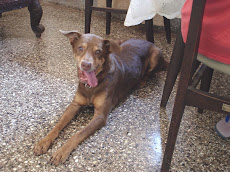



I saw a prototype of what Goa will be in the next ten years. If you want to see it too, take a trip to Indira Gandhi Slum Colony at the far end of Chimbel. For a slum colony, it is in pretty good shape. The roads are quite straight, definitely in far better shape than 31st January Road of Panjim. Children are fairly well dressed, clean, no fly-infested running noses or malnutrition bellies. There are scooters, rickshaws, motorcycles and cars. Everyone has a cell phone and the panch’s Nokia N 70 Music edition cell-phone rang regularly.
Indira Nagar has spread from a few houses built off the main road of Chimbel in the mid-70s. Victoria Fernandes aka Mummy can measure the growth of her political career in direct ratio with the growth of Indira Nagar. “First no one wanted to stay there,” she told me, “There was too much sickness and disease and they kept seeing the ghost of a priest. But I went and stayed there with them for a while and everything was better. I fought for them all these years, to make their conditions better and better. Now more and more people want to come and stay here. These are my people,” she said. The sickness stopped and the priestly ghost disappeared permanently. I explored the colony escorted by two panchs, one from Tamilnadu and the other from Andhra Pradesh; both have spent most of their lives in Goa.
The original cluster of houses built by the Union Government was a cluster of tiny 20 sq metre houses. These were divided and subdivided, let and sub-let, as more people poured into Goa from the southern states, they found their way to Indira Nagar which began spreading and growing like living thing expanding along its sides and crawling up the hill. Even a block of toilets was converted into living quarters and rented out.
A mysterious fire engulfed a part of the area, but like the Phoenix Indira Nagar emerged from the ashes stronger than ever and continued growing with subsequent governments. Houses were demolished and rebuilt as neat 100 sq metre homes under the 20-point programme by Governor Bhanu Pratap Singh. Once section came up during Manohar Parrikar’s time and the rest during Pratapsing Rane’s numerous stints as CM. Throughout their angel of mercy was Mummy Victoria Fernandes and they her largest votebank.
The houses are painted and plastered, thanks to the recent elections where Jennifer Monserrate and Victoria squared up to each other and doled out largesse. The slum has two temples, two churches and one large mosque with an Anjuman Islam school on the premises occupying pride of place up on the hill. The school has computers sent from the Central Government, computers with Urdu software. The mosque has four minarets pointing at the sky, all four donated by a wealthy Muslim. There are three burial grounds at the top of the hill, one Hindu, one Muslim and one Christian.
There was not much garbage lying around, maybe because in the run-up to Ganesh Chaturthi, sixty trucks of garbage were lifted from Indira Nagar. No one knows where they dumped their load.
It’s a mini-India or a prototype of Goa in the next decade, depends on how you look at it. One section is lined with Andhra Pradesh houses, 120 in all. The Tamil Nadu section makes up around 160 houses. There are very few Kerala houses, just about four or five. People from Karnataka are the largest numbering around 650-700 houses people largely by Muslim families from Karnataka. Goans make up 200 houses. The panchs were sure that there were around 10,000 residents at Indira Nagar. There is a very large representation of North Indians from Bihar Orissa, UP and Rajasthan too, but these live in rented premises.
There’s gambling, alcoholism, and every other vice one can think of. Fights break out on a regular basis and they knock on Victoria’s door to ease their way out of jail or into hospital. Everyone from diverse cultural backgrounds live in close but uneasy proximity. Are you afraid of inter-communal riots breaking out, I asked the panchs. “We think about it,” said one. “It’s hard living here with so many different types of people. Sometimes it is really bad, but we have no choice, we have to live with ourselves and each other. But then there are these three burial grounds lying next to each other; we can’t forget that we’ll all end up there some day.”
(Published in Herald January 13, 2008)







1 comment:
nice article. I would like to know more on the topic.. if you could then.. my email id is tushankunkolienkar@indiatimes.com
Post a Comment